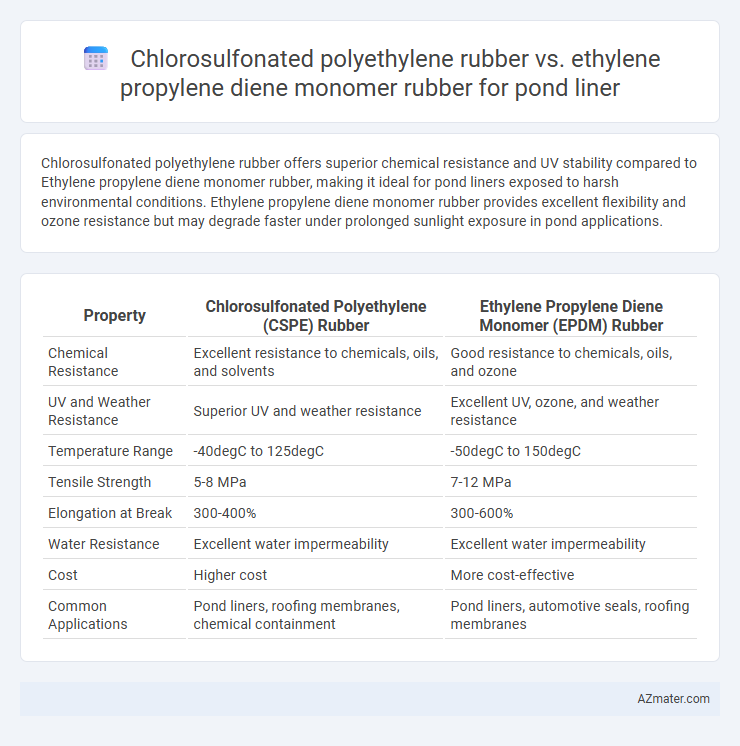Chlorosulfonated polyethylene rubber offers superior chemical resistance and UV stability compared to Ethylene propylene diene monomer rubber, making it ideal for pond liners exposed to harsh environmental conditions. Ethylene propylene diene monomer rubber provides excellent flexibility and ozone resistance but may degrade faster under prolonged sunlight exposure in pond applications.
Table of Comparison
| Property | Chlorosulfonated Polyethylene (CSPE) Rubber | Ethylene Propylene Diene Monomer (EPDM) Rubber |
|---|---|---|
| Chemical Resistance | Excellent resistance to chemicals, oils, and solvents | Good resistance to chemicals, oils, and ozone |
| UV and Weather Resistance | Superior UV and weather resistance | Excellent UV, ozone, and weather resistance |
| Temperature Range | -40degC to 125degC | -50degC to 150degC |
| Tensile Strength | 5-8 MPa | 7-12 MPa |
| Elongation at Break | 300-400% | 300-600% |
| Water Resistance | Excellent water impermeability | Excellent water impermeability |
| Cost | Higher cost | More cost-effective |
| Common Applications | Pond liners, roofing membranes, chemical containment | Pond liners, automotive seals, roofing membranes |
Introduction to Pond Liners: Key Functions and Requirements
Chlorosulfonated polyethylene (CSPE) rubber offers excellent chemical resistance, UV stability, and flexibility, making it suitable for pond liners exposed to harsh environmental conditions. Ethylene propylene diene monomer (EPDM) rubber provides superior elasticity, ozone resistance, and durability, essential for maintaining pond liner integrity under temperature fluctuations and mechanical stress. Both materials meet key pond liner requirements, including impermeability, resistance to punctures, and long-term performance in aquatic environments.
Overview of Chlorosulfonated Polyethylene (CSPE) Rubber
Chlorosulfonated polyethylene (CSPE) rubber, widely used in pond liners, offers excellent chemical resistance, UV stability, and durability against harsh environmental conditions. Its ability to withstand oxidation, ozone, and various temperature fluctuations makes CSPE an effective choice for long-lasting water containment applications. Compared to ethylene propylene diene monomer (EPDM) rubber, CSPE demonstrates superior resistance to oils and solvents, which enhances its performance in chemically aggressive environments.
Overview of Ethylene Propylene Diene Monomer (EPDM) Rubber
Ethylene Propylene Diene Monomer (EPDM) rubber is a synthetic elastomer renowned for its exceptional resistance to UV rays, ozone, and weathering, making it ideal for outdoor pond liners. EPDM maintains flexibility across a wide temperature range and exhibits excellent water resistance, ensuring long-lasting durability in aquatic environments. Compared to Chlorosulfonated Polyethylene (CSPE) rubber, EPDM offers superior elasticity and chemical stability, enhancing its performance and lifespan in pond liner applications.
Material Properties: CSPE vs EPDM
Chlorosulfonated polyethylene (CSPE) rubber offers excellent resistance to UV radiation, ozone, and chemical degradation, making it highly durable for pond liners exposed to harsh environmental conditions. Ethylene propylene diene monomer (EPDM) rubber excels in flexibility, elongation, and resistance to weathering, particularly in low temperatures, ensuring superior performance in colder climates. While CSPE provides robust chemical resistance and moderate elasticity, EPDM's superior tensile strength and exceptional weather resistance make it a preferred choice for long-lasting pond liners.
Resistance to UV, Weathering, and Ozone Exposure
Chlorosulfonated polyethylene (CSPE) rubber offers superior resistance to UV radiation, weathering, and ozone exposure compared to ethylene propylene diene monomer (EPDM) rubber, making it highly suitable for pond liner applications in harsh outdoor environments. CSPE's chlorine and sulfonyl functional groups provide enhanced chemical stability and durability against oxidative degradation caused by sunlight and ozone. EPDM exhibits good resistance but may degrade faster under prolonged UV exposure and ozone, reducing its long-term performance in exposed pond liner installations.
Chemical Compatibility and Durability in Pond Environments
Chlorosulfonated polyethylene (CSPE) rubber exhibits superior chemical resistance against acids, alkalis, and solvents, making it highly compatible with diverse pond water chemistries, including those influenced by fertilizers and pesticides. Ethylene propylene diene monomer (EPDM) rubber offers excellent ozone, UV radiation, and weathering resistance, ensuring long-term durability in outdoor pond environments but is less resistant to petroleum-based contaminants compared to CSPE. Both materials provide effective pond liner solutions; however, CSPE excels in chemical compatibility while EPDM stands out in resilience to environmental degradation.
Flexibility and Ease of Installation
Chlorosulfonated polyethylene (CSPE) rubber offers excellent flexibility, maintaining its elasticity even in extreme temperatures, which ensures a snug fit around pond contours and reduces the risk of cracking during installation. Ethylene propylene diene monomer (EPDM) rubber is highly flexible but can be slightly more rigid at low temperatures, potentially complicating installation in colder climates. The superior flexibility of CSPE facilitates easier handling and faster installation, making it the preferred choice for complex pond liner applications.
Lifespan and Maintenance Considerations
Chlorosulfonated polyethylene (CSPE) rubber offers an impressive lifespan of up to 30 years in pond liner applications due to its excellent chemical resistance and UV stability, minimizing frequent repairs. Ethylene propylene diene monomer (EPDM) rubber typically provides a lifespan of 20-25 years with high flexibility and weather resistance but may require more maintenance in harsh chemical environments. CSPE liners demand less maintenance over time, especially in ponds exposed to oils or chemicals, while EPDM liners excel in environments focusing on elasticity and ease of installation.
Environmental Impact and Sustainability
Chlorosulfonated polyethylene (CSPE) rubber offers superior chemical resistance and durability for pond liners but tends to have a higher environmental impact due to its chlorinated components and challenges in recycling. Ethylene propylene diene monomer (EPDM) rubber provides excellent UV and ozone resistance while being more amenable to recycling and generally exhibiting lower toxicity in production and disposal. EPDM's increased sustainability profile makes it a preferred choice for eco-conscious pond lining applications.
Cost Comparison and Value for Pond Owners
Chlorosulfonated polyethylene (CSPE) rubber offers higher chemical and UV resistance but generally comes at a higher initial cost compared to Ethylene Propylene Diene Monomer (EPDM) rubber, which is more budget-friendly yet durable for pond liners. EPDM's flexibility and ease of installation provide excellent value for pond owners looking to balance cost efficiency and performance over time. Considering lifespan and maintenance, EPDM often delivers better cost-effectiveness for standard pond applications, while CSPE suits environments requiring enhanced chemical resilience.

Infographic: Chlorosulfonated polyethylene rubber vs Ethylene propylene diene monomer rubber for Pond liner
 azmater.com
azmater.com